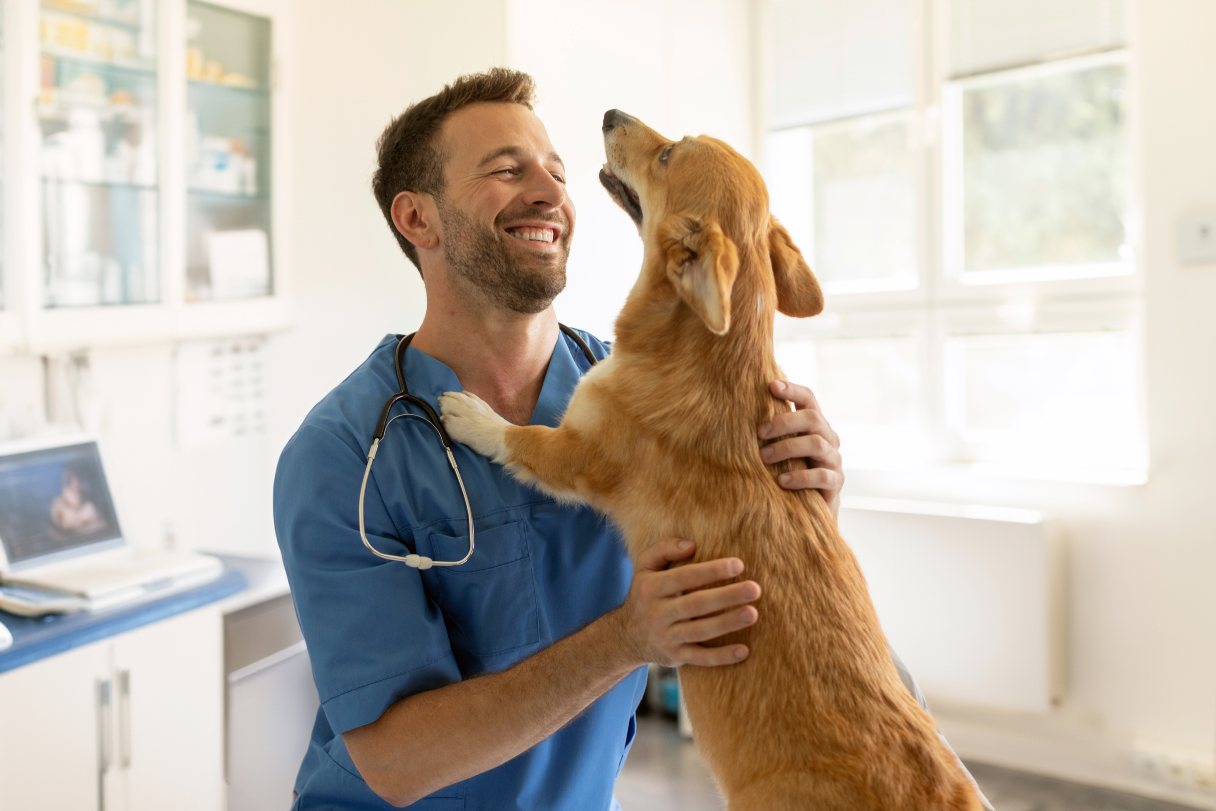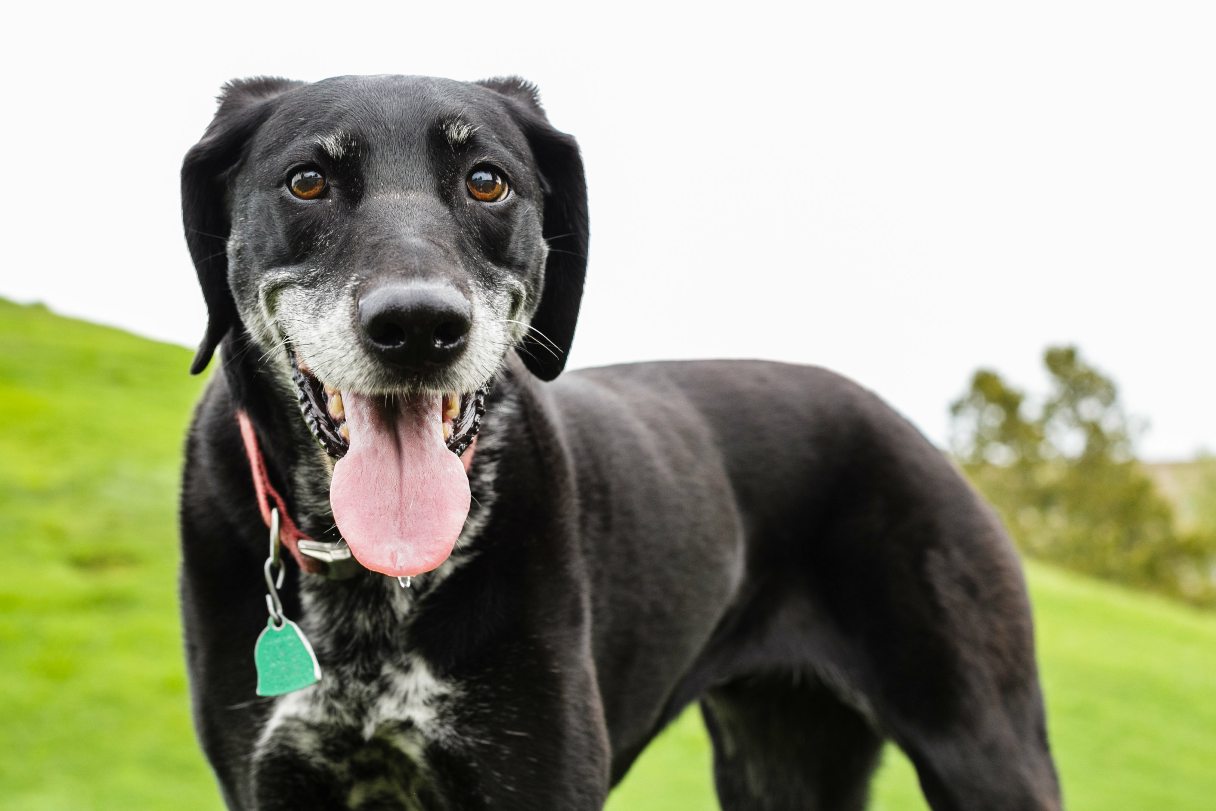If your dog's eyes look cloudy and they're hesitating at stairs or bumping into furniture, they may have cataracts. Cataracts are common in dogs older than 10 years of age and likely affect all dogs older than 13 years to some degree.1
Additionally, about 75% to 80% of diabetic dogs develop cataracts within the first year of diagnosis.2 Since cataracts are a frequent cause of blindness in dogs, pup parents should know what to expect if their four-legged friend is affected.3
What Are Cataracts?
A cataract is an opacity that develops in the eye’s lens. The lens is a structure that sits behind the iris and focuses light onto the retina, allowing for clear vision. The lens is normally clear, but when a dog develops a cataract, the lens becomes opaque, causing a cloudy appearance. This opacity interferes with light’s ability to reach the retina and can affect a dog’s vision.4
Common causes
While cataracts are more common in senior dogs, they can occur in dogs of all ages. Common causes include:2
- Aging. Cataracts can develop as a result of the aging process.
- Chronic uveitis. Chronic inflammation of the deep tissues of the eye can result in cataract formation.
- Diabetes mellitus. Diabetic dogs have excess glucose (i.e., blood sugar), which can pull water into the lens, leading to rapid cataract formation.5
- Eye trauma. Eye trauma can damage the lens, causing a cataract.
- Genetics. Certain dog breeds are more susceptible to cataracts than others. Breeds with a high predisposition include the cocker spaniel, Labrador retriever, poodle, Boston terrier and Welsh springer spaniel.4
- Nutritional deficiencies. Puppies fed an inadequate diet can form cataracts.
The only successful treatment for cataracts in dogs is surgery.
How Much Does Cataract Surgery for Dogs Cost?
The national average cost* for dog cataract surgery is $3,600 and can range from $2,000 to $5,800.6 Prices may vary depending on location, complexity of the surgery and other factors.
Calculate the cost of cataract surgery for dogs near you

Explore procedure costs in your area
Average cost of dog cataract surgery by state/district
The table below shows the average cost* of dog cataract surgery in all 50 states and the District of Columbia:6
| State/District | Average cost |
|---|---|
| Alabama | $3,528 |
| Alaska | $3,721 |
| Arizona | $3,410 |
| Arkansas | $3,428 |
| California | $3,515 |
| Colorado | $3,292 |
| Connecticut | $3,618 |
| Delaware | $3,285 |
| District of Columbia | $3,445 |
| Florida | $3,660 |
| Georgia | $4,060 |
| Hawaii | $3,865 |
| Idaho | $3,970 |
| Illinois | $3,576 |
| Indiana | $2,994 |
| Iowa | $3,569 |
| Kansas | $3,713 |
| Kentucky | $3,096 |
| Louisiana | $3,537 |
| Maine | $3,748 |
| Maryland | $3,917 |
| Massachusetts | $3,673 |
| Michigan | $3,819 |
| Minnesota | $3,504 |
| Mississippi | $3,411 |
| Missouri | $3,252 |
| Montana | $3,479 |
| Nebraska | $4,019 |
| Nevada | $3,790 |
| New Hampshire | $3,734 |
| New Jersey | $3,094 |
| New Mexico | $3,552 |
| New York | $3,734 |
| North Carolina | $3,559 |
| North Dakota | $3,557 |
| Ohio | $2,963 |
| Oklahoma | $3,180 |
| Oregon | $3,910 |
| Pennsylvania | $3,853 |
| Rhode Island | $3,185 |
| South Carolina | $3,416 |
| South Dakota | $3,781 |
| Tennessee | $4,046 |
| Texas | $3,828 |
| Utah | $3,414 |
| Vermont | $4,233 |
| Virginia | $3,595 |
| Washington | $3,893 |
| West Virginia | $4,058 |
| Wisconsin | $3,534 |
| Wyoming | $3,202 |
Is Cataract Surgery for Dogs Covered by Pet Insurance?
Cataract surgery is typically covered by accident and illness pet insurance plans as long as the cataracts were not present before coverage started. The amount you will be reimbursed depends on the terms of your policy, such as the deductible, reimbursement rate and maximum coverage limit.7
How Dog Cataract Removal Works
Cataract removal surgery for dogs is performed by a veterinary ophthalmologist and involves:3
- Presurgical testing. Before surgery, your vet and the veterinary ophthalmologist will perform diagnostics, such as blood work, urinalysis, an ocular ultrasound and retinal functional testing (i.e., electroretinogram).
- General anesthesia. Dogs undergoing cataract surgery must be anesthetized.
- Phacoemulsification. During the procedure, the veterinary ophthalmologist makes a small incision in the cornea, which allows access to the lens. They then make a hole in the lens capsule and use an ultrasonic device to break up and remove the lens material, a process known as phacoemulsification. Once the cataract is removed, an artificial lens is inserted in the capsule, and the incision is closed.
- After-surgery care. Most dogs are discharged the day after surgery and must wear an Elizabethan collar to prevent them from damaging the surgical site. Topical eye medications are typically given four times a day for several weeks, and recovery usually takes about four weeks. Follow-up visits with your veterinary ophthalmologist are necessary to evaluate the healing process.
Potential Complications
The best time to perform cataract surgery is in the early stages, before the cataract is mature. The success rate for cataract surgery in dogs who are good surgical candidates is about 80% to 90%.2 However, complications can occur and may include:3
- Dry eye. Dry eye, also known as keratoconjunctivitis sicca (KCS), is a common complication in diabetic dogs and results in inadequate tear production. Treatment usually involves long-term topical and anti-inflammatory medications.
- Glaucoma. Increased ocular pressure is another potential complication. Medications and surgical intervention can usually manage this condition, but if the pressure can’t be controlled, your veterinarian may recommend surgically removing the eye.
- Retinal detachment. In some cases, the retina separates from the back of the eye. If this occurs, surgical repair may be possible.
- Secondary cataract. A condition called posterior capsular opacification can occur, which causes cloudiness in the lens capsule. This condition can typically be treated with laser therapy.5
- Uveitis. Inflammation can develop inside the eye after cataract surgery. This complication is typically treated by administering topical medications more frequently.
When Is Cataract Surgery Not Recommended for Dogs?
Surgery is not the best option for every dog with cataracts. Considerations include:2
- Eye health. Your dog’s retina and cornea must be healthy for a good surgical outcome, and cataract surgery is not recommended if they have glaucoma or uveitis.
- Overall health. If your dog is very old or not in good health, putting them through surgery may not be in their best interest.
- Your capability. Treatment after cataract surgery can be intense, and you must be able to administer the appropriate care to your dog for a good outcome.
- Your dog’s temperament. Some dogs won’t tolerate eye drop administration and may become aggressive. These dogs may not be ideal candidates for cataract surgery.
Cataract Surgery to Restore Vision
If your dog has cataracts, their vision may be affected. Fortunately, cataract surgery can provide a successful outcome and help restore their vision. Consult your veterinarian to determine if cataract surgery is a good option for your four-legged friend.
Frequently Asked Questions About Cataract Surgery for Dogs
Do you still have questions about cataract surgery in dogs? Here are answers to some frequently asked questions.
Financing Cataract Surgery With the CareCredit Credit Card
Your dog is your best friend, and you want to make sure they get the very best. That's why the CareCredit credit card is here to help you manage the costs of diagnostics and treatment for conditions like cataract surgery.** Use our Acceptance Locator to find a veterinarian near you that accepts CareCredit. CareCredit is there for you and your pet every step of the way; continue your wellness journey by downloading the CareCredit Mobile App to manage your account, find a provider on the go and easily access the Well U blog for more great articles, podcasts and videos.
In addition to pet care, you can also use your CareCredit credit card for dentistry, cosmetic, vision, hearing, health systems, dermatology, pharmacy purchases, spa treatments and so much more within the CareCredit network. How will you invest in your health and wellness next?
Author Bio
Angela Beal, D.V.M., has more than 20 years of experience as a veterinarian. Leveraging her background in private practice and academia, she uses her passion for writing to convey information to pet owners to help them keep their pets healthy and happy.







